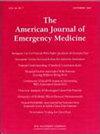医疗保险受益人之间可能避免的急诊科转移
IF 2.7
3区 医学
Q1 EMERGENCY MEDICINE
引用次数: 0
摘要
患者在医院之间的转移是常见的,昂贵的,估计超过20%是可以避免的,这意味着患者一旦转移就没有接受专门的干预措施。老年人更有可能被转移,并且由于转移而出现谵妄或其他并发症的风险可能会增加。我们旨在确定老年人中潜在可避免转移(PAT)的频率;确定最有可能涉及PAT的情况;并描述与PAT相关的因素。方法:我们对2008年至2019年65岁及以上的医疗保险服务收费受益人中因急诊科就诊而转院的患者进行了回顾性分析。我们根据接收医院的资源使用情况来定义PAT——导致治疗后出院的急诊科就诊、观察住院或住院2天或更短、未接受重症监护或高级手术且活着出院的患者。我们确定了PAT发生率最高的条件,并使用多变量logistic回归来确定患者、诊断、医院和社区相关特征与PAT的独立关联。结果在约300万次转移中,11.3%符合PAT标准。转院的PAT率各不相同,平均(IQR)率为10.3%(7.2% - 14.6%)。PAT发生率高的情况包括短暂性脑缺血(35.3%)、非特异性胸痛(25.5%)、晕厥(22.9%)、其他骨折(18.4%)和颅内损伤(16.9%)。在多变量logistic回归中,这些情况也与PAT相关(与脓毒症转移相比,平均边际效应[AME]分别为28.2% (95% CI 27.4-29.1)、20.6%(19.8-21.5)、19.2%(18.5-19.9)、13.4%(12.9-13.9)和12.8%(12.2-13.4))。年龄在85岁及以上、女性、非白人、合并症较少、大型、营利性、教学和关键医院以及无保险率高的县的患者与PAT的可能性较高相关。安全网和农村医院以及贫困率高的县的医院与PAT的可能性较低相关。pats在老年人转移中很常见,特别是在神经系统、心血管和损伤相关疾病的亚群中。这些条件可能是理想的干预目标,以减少可避免的转移率。还需要研究医院在转院实践中的差异以及PAT对老年人健康结果的影响。本文章由计算机程序翻译,如有差异,请以英文原文为准。
Potentially avoidable emergency department transfers among Medicare beneficiaries
Introduction
Transfer of patients between hospitals is common, costly, and over 20 % are estimated to be avoidable, meaning patients do not receive specialized interventions once transferred. Older adults are more likely to be transferred and may be at increased risk for developing delirium or other complications due to transfer. We aimed to determine the frequency of potentially avoidable transfer (PAT) among older adults; identify conditions most likely to involve a PAT; and describe factors associated with PAT.
Methods
We performed a retrospective analysis of ED visits resulting in transfer to another hospital from 2008 to 2019 among Medicare fee-for-service beneficiaries 65 years and older. We defined PAT based on resource use at the receiving hospital – transfers resulting in a treat-and-release ED visit, observation stay, or inpatient hospitalization for 2 days or less who received no intensive care or advanced procedure and were discharged alive. We identified conditions with the highest rates of PAT and used multivariable logistic regression to identify the independent association of patient, diagnosis, hospital, and community-linked characteristics with PAT.
Results
Among ∼3 million transfers, 11.3 % met criteria for PAT. Transferring hospitals varied in their rates of PAT, with a median (IQR) rate of 10.3 % (7.2–14.6). Conditions with high rates of PAT included transient cerebral ischemia (35.3 %), nonspecific chest pain (25.5 %), syncope (22.9 %), other fractures (18.4 %), and intracranial injury (16.9 %). These conditions were also associated with PAT in multivariable logistic regression (average marginal effect [AME] 28.2 % (95 %CI 27.4–29.1), 20.6 % (19.8–21.5), 19.2 % (18.5–19.9), 13.4 % (12.9–13.9), and 12.8 % (12.2–13.4), respectively, compared to transfers for sepsis). Patients who were age 85 and older, female, non-White, had fewer comorbidities, and large, for-profit, teaching, and critical access hospitals, and counties with high uninsurance rates were associated with higher likelihood of PAT. Safety net and rural hospitals, and hospitals in counties with high poverty rates were associated with lower likelihood of PAT.
Discussion
PATs were common in transfers of older adults, particularly among a subset of neurologic, cardiovascular, and injury-related conditions. These conditions may represent ideal targets for intervention to decrease rates of avoidable transfer. Research exploring hospital variation in transfer practices and the impact of PAT on older adults' health outcomes are also needed.
求助全文
通过发布文献求助,成功后即可免费获取论文全文。
去求助
来源期刊
CiteScore
6.00
自引率
5.60%
发文量
730
审稿时长
42 days
期刊介绍:
A distinctive blend of practicality and scholarliness makes the American Journal of Emergency Medicine a key source for information on emergency medical care. Covering all activities concerned with emergency medicine, it is the journal to turn to for information to help increase the ability to understand, recognize and treat emergency conditions. Issues contain clinical articles, case reports, review articles, editorials, international notes, book reviews and more.

 求助内容:
求助内容: 应助结果提醒方式:
应助结果提醒方式:


